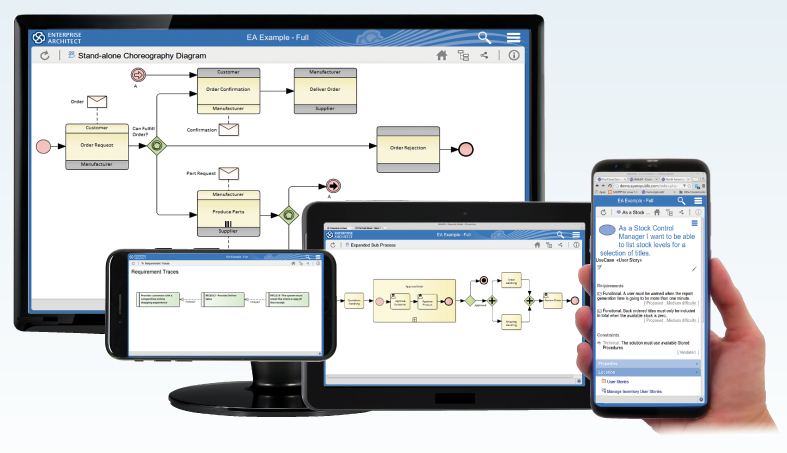
The growth and evolution of business has required a growth and evolution in modeling, which has emerged as a way to communicate ideas and minimize complexity across the enterprise. Modeling is used to get a handle on business processes, database design, code engineering — and even the enterprise itself, through organizational charts, workflows and enterprise frameworks.
Sparx Systems, whose Enterprise Architect modeling platform enables teams to collaborate on business rules, requirements and more to create UML 2.5-based models, last month came out with Pro Cloud Server, a web-based platform that gives all project stakeholders a way to create, review, comment on and edit models, diagrams and processes from any browser and device.
According to Geoffrey Sparks, founder and CEO of Sparx Systems, “The ability to dynamically create, collaborate and integrate models over multiple domains and technical platforms is a remarkable and highly agile solution that has the capacity to radically improve the quality, accuracy and effectiveness of model-based projects.”
Sparx has 580,000 registered users of Enterprise Architect, and was listed in the Challenger category of the latest Gartner Enterprise Architecture Magic Quadrant.
The Pro Cloud Server currently boasts three main areas. The first is a comprehensive RESTful API for OSLC (Open Services for Life-cycle Collaboration.) This is the platform that provides access to the back-end Enterprise Architect repository. The second is WebEA, WebEA builds off the RESTful API and provides a mobile interface into the model allowing the model to be consumed, commented and discussed from any device with a web browser. The third is a URL based approach to connecting to both these services allowing a secure http(s) connection without the need for database specific drivers or configurations for each platform.
Having the ability act quickly and collaboratively reflects a radical change in enterprise architecture, according to a presentation at a Gartner Enterprise Architecture Summit conference. Organizations need to address business disruptions coming from all angles by embracing digital technologies such as cloud computing, intelligent machines and more.
“EA success in the digital age is fueled by a spirit of alignment and collaboration with business and IT stakeholders throughout the enterprise,” Gartner wrote in a summary of the summit. “EA practitioners must be willing and able to reimagine traditional EA roles and responsibilities and develop a new business acumen and digital skill sets.”
Focus on the business analyst
Along with the release of Pro Cloud Server, Sparx worked with the International Institute of Business Analysis to create and release a public beta of a toolkit for the Business Analysis Body of Knowledge® (BABOK® Guide v3). The model, when implemented within Pro Cloud Server, is designed to give business analysts the ability to collaborate on requirements and business models, to provide better business outcomes.
“It is the first time business analysis techniques have been actualized in this way and we are excited with the outcome,” said Sparx Systems COO Tom O’Reilly. “The solution… has the capacity to revolutionize the way the BABOK Guide v3 is applied within the enterprise.”
The Tools and Techniques for BABOK Guide v3 instructs the professional on implementing business analysis standards that offer reliability, repeatability and improved productivity, according to Sparks. Better requirements capture and management result in better project outcomes.
Analysts have to reach out to various departments to assess their needs, then write it out, analyze it and deliver it in technical language to the development team. Without adequate tooling to handle requirements, this task alone can add months to a software project.
Especially in today’s software development environment of agile practices and continuous integration/deliver, the need to respond quickly to customer feedback as well as the needs of the business requires that collaborative tools be in place to let stakeholders work through their needs while providing transparency into the change process.
As Sparks noted in a recent blog post: “These examples are a reflection of the changes in the Requirements Management process, which in the development model of today, supports iterative requirements gathering and continuous delivery of software. It has become an Agile practice approach, being adopted to address the challenge of digital transformation. This collaborative, iteration based business lifecycle, between requirements and stakeholders, has given rise to DevOps, a strategy for managing continuous change.
Enterprise Architect is unique in its ability to support requirements throughout the development lifecycle and to deliver the benefits of the Agile practice approach. Requirements can be defined in the model, or imported from other tools including Visio.”
An organization using the WebEA view into the Enterprise Architect Cloud could have a business analyst or project manager create requirements, use cases, tests and more right in the mobile browser. This ability to capture task assets remotely for use in a model later on helps make the process more agile.
What exactly is enterprise architecture?
For a younger generation of developers and business analysts, the term ‘enterprise architecture’ might not be totally understood. Yet EA could very well help them – and their organizations – better compete in a world that is changing ever more rapidly.
In fact, according to a paper titled “A Common Perspective on Enterprise Architecture” produced by the Federation of Enterprise Architecture Professional Organizations, EA was first developed to help companies deal with the shifting, sliding technology landscape and with diversity in operating systems.
Today, enterprise architecture continues to be implemented, but instead of helping organizations deal with a migration off mainframes onto distributed systems, for example, it is being used to help organizations make a digital transformation. Through the use of models, EA gives adopters repeatable techniques to map out their future – whether that’s a migration to the cloud, or implementing a strategy for mobile device access to data – and ensure its success.
According to the paper, “Organizational changes can be dramatic, with large-scale reorganization of people, systems and accountabilities. They can also be gradual and steady, involving hundreds of small, non-disruptive steps. Regardless of the approach taken, change is often complex and error-prone. Enterprise Architecture, through continuous evaluation and adaptation of the enterprise, reduces the cost of change and improves the chances for success.”
More detailed information on Sparx, Enterprise Architect, Pro Cloud Server and WebEA can be found at www.sparxsystems.com






